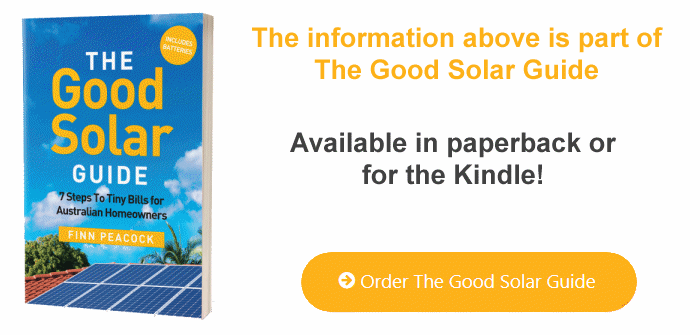Your electricity connection
← Energy Audit | The Good Solar Guide Contents | Reading Your Meter →
Let’s start with how your home is physically connected to the mains electricity grid. It will be:
- single phase
- two phase, or
- three phase
If you have two phase or three phase, each phase may have a separate meter or they may all go into a single meter.
Single phase, two phase and three phase explained
Single phase. Most Australian homes have ‘single phase’ electricity. This means that they have one live wire to their home carrying all their electricity. This wire is called the ‘active’ conductor. There is a second wire, called the ‘neutral conductor’, which provides a return path because – as you should remember from primary school science – electricity always needs a circuit to flow round.
Two phase. Two phase supplies are rare, but some people have them. Two phase means there are two live wires going into your home.
Three phase. As people get bigger homes and more powerful appliances, such as large air conditioners and pool heaters, they may need more power than can flow down a single wire. For this reason, more and more homes are getting ‘three phase’ connections. As you have probably already guessed, three phase means that you get three live (or active) wires instead of one. It follows that you can have three times the power coming into your home.
If you have three phase power, the phases are called red, white and blue. Your single phase appliances run off one of those phases. Any large, three phase appliances are connected into all three phases.
As electric cars become common, people will start to upgrade to three phase so they can charge the car more quickly.
The first thing we want to determine is: how many phases do you have?
If you know how many phases you have (one, two or three), then record it here or on the worksheet:
My home has a _____ phase supply.
If you aren’t sure how many phases you have, you could call your electricity retailer and ask. If one of your neighbours is technical, you can ask them.
Or, you can snap a picture of your switchboard and email it to: [email protected].
Make the subject of your email ‘How many phases do I have?’ and we’ll work it out for you.
Do you have a ‘controlled load’ supply?
Now you know how many phases you have, we need to see if you have a special separately metered, cheaper tariff for running your electric hot water (and perhaps your underfloor heating or pool pump too). This tariff is called:
- off-peak
- controlled load
- economy, or
- dedicated circuit consumption
It could also have some other obscure name, depending on your retailer and local network. This cheaper tariff may need a separate meter, or it may be measured inside one of your other electricity meters.
If you are in Western Australia, you won’t have one of these tariffs because they don’t do them there. In the rest of Australia, you may have one if you have electric hot water, underfloor heating or a pool pump. The best way to find out is by looking at your bill.
Most bills will list all your tariffs on the back page, as in Figure 2.2.
This example is for a poor bugger with a very complicated electricity tariff. She is on a time-of-use tariff, which charges different amounts depending on the time of day.
| Electricity charges: 11 May 2014 – 10 August 2014 (92 days) | Rate $ per kWh | Total $ |
| Peak – first 411 kWh | $0.3124 | $128.40 |
| Peak – next 452 kWh | $0.3245 | $146.67 |
| Peak – next 389 kWh | $0.3455 | $134.40 |
| Off peak – 628 kWh | $0.1250 | $78.50 |
| Shoulder 1 – 455 kWh | $0.2750 | $125.13 |
| Shoulder 2 – 256 kWh | $0.2365 | $60.54 |
| Controlled load – 408 kWh | $0.1050 | $42.84 |
| Service to property charge – 92 days | $0.5384 | $49.53 |
| Total electricity charges (Ex. GST) | $766.01 | |
| Total electricity charges (Inc. GST) | $842.61 |
Figure 2.2 Range of tariffs listed on the back of an electricity bill; most people only have one or two.
She also has a controlled load tariff, which is the cheapest tariff of the lot at 10.5c per kWh.
If you’re on a time-of-use tariff like this one, please consider moving to a simple standard tariff.
Online resource: Why time-of-use tariffs are generally bad news: solarquotes.com.au/tou
If you’re on a simple flat tariff like this one, the back of your bill may look like Figure 2.3:
| New charges and credits | ||||
| Usage and supply charges | Units | Price | Amount | |
| Peak | 419 kWh | $0.2615 | $109.57 | |
| Tariff 33 Controlled load | 331 kWh | $0.1898 |
$62.82 |
|
| Supply charge | 96 days | $0.8581 |
$82.38 |
|
| Total charges | + $254.77 | |||
Figure 2.3 A bill with only ‘peak’ and ‘controlled load’ tariffs.
Here, the controlled load is obvious at 18.98c per kWh.
Write down if you have a controlled load tariff here or on the worksheet:
I have a controlled load tariff:_____(Yes/No)
If you can’t work it out from your bill, send a copy of it to [email protected] with the subject ‘controlled load’ and we’ll decipher it for you.
← Energy Audit | The Good Solar Guide Contents | Reading Your Meter →
Questions or feedback about the content on this page? Contact me.
